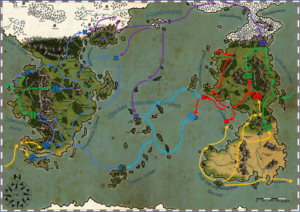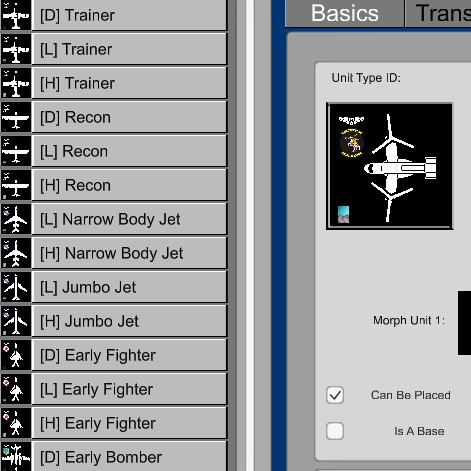Empire Deluxe Tournament 2019 – Week Two
 Week Two saw an equally competitive game with all six players opting to participate in the follow up. There are some minor changes to the starting locations. This game would see air power become the deciding factor in victory as well as the return of infantry slogs. In the end it didn’t matter who chose what, as the game would be a lopsided win for one player in particular.
Week Two saw an equally competitive game with all six players opting to participate in the follow up. There are some minor changes to the starting locations. This game would see air power become the deciding factor in victory as well as the return of infantry slogs. In the end it didn’t matter who chose what, as the game would be a lopsided win for one player in particular.
The Start
The game map attached to this post shows the course of events as they played out. Note that due to a mapping imperfections, the true size of the continents is slightly wider. This will cause some distortions in the visuals but are a reflection of how events played out on the game map. Here are the starting locations for the first game:
| Red | Blue | Green | Pink | Yellow | Cyan |
| Feuer | Gestila | Niefsa | Nordmeer | Aufgehenden | Hafenheim |
First Half
Taylo’s stunning sea victory last game saw a slow start as most players built up their navies before committing to extensive land invasions. In fact Hafenheim, the successor to Taylo, made an attempt to repeat success by attacking Kuste and Xi’jing early in the game only to find them empty of any competition.
The landings at Xi’jing would actually prove to be Hafenheim’s undoing in the second half of the game. Feuer had correctly guessed that the high value Xi’jing would be an early target and instead focused its strategy on securing the entire continental border early in the game to ensure any amphibious assaults from the sea would be costly. This extra preparation would cost them an early expansion to the east, but that area would also prove to be contentious.
Niefsa started with an early sea expansion west. The strategy was to secure a foothold on two continents before any other competitor was able to rival them. The plan was to then secure the mountain fortresses to the east and allow them a stronghold to operate uncontested. Unfortunately, the landing attempts on the eastern continent took longer than expected. By the time they reached Rongulay, Gestila was already sending forces into the Roninwald Valley.
Nordmeer secretly opted to disrupt the flow of the game rather than attempt to achieve victory. The strategy would be a wild success. They built a large fleet that headed in three separate directions. To the west they were able to capture Trollowy Las and Piryat much like the first game, but also managed to reach Frostberg on the eastern continent by mid game as well.
Aufgehenden opted to build a naval force capable of swiftly expanding up the coastline. This resulted in some early success as the expansion and capture of the Himmels Berge and Giol Berge were swift. However, the fleet sent up the west coast soon met with a fleet from Feuer and a war of attrition on the sea began near Ediman.
The biggest surprise in the first half was the opening moves by Gestila. Despite the risk of invasion by sea, Gestila opted to make an armored rush up the western continent. It was a bold move, bypassing cities, with no air support, and no supply lines. But by the end of the first half, the move would pay off as it controlled the very high value cities along the Rek River. The end of the first half would actually be marked by the capture of Reichshauptstadt which would not leave Gestila’s control for the rest of the game.
Second Half
The first major engagement of the second half was the Battle of Ediman which saw a swift retreat of Feuer back to the waters near Riosu. Here, along with naval reinforcements from the north and aircraft from two secret air bases nearby, were able to overwhelm the Aufgehenden forces at the Battle of Riosu Harbor. While Aufgehenden denies it was part of their strategy, had Feuer lost this battle there would have been little to prevent an invasion of their home island.
At the same time, the preparations against Hafenheim in the west were put to the test at the Battle of Matsuba. A joint land and sea invasion of the peninsula was conducted from Xi’jing. However, the Battle of Riosu Harbor had just ended and Feuer was able to assemble its forces to meet them head on. A fierce air battle eventually ended with an exhausted but victorious Feuer force. With no air cover, the heavily damaged cruiser force was able to mop on amphibious troops on the coastline and prevent future landings. This resulted in a victory for Feuer, but the cost of the Battle of Riosu Harbor and Battle of Matsuba combined had depleted the navy and air force of desperately needed units and would prevent them from counter attacking.
To make matters worse, Feuer invaded the high value Roninwald Valley only to find it under attack by Niefsa. The resulting war of attrition would completely devastate the valley. This war would cost Feuer all of its remaining ground forces, effectively depleting all of its reinforcements in the Battle of Tagaru. As a result, while Feuer would hold on until the end of the game, it was a mere shell of the powerhouse it was in the first half of the game.
Niefsa wasn’t faring much better. The entire eastern continent was a constant battleground. To the south, it held the pass at the Battle of Baachan against Aufgehenden. However, the force were later outflanked by a surprise attack at the Battle of Sumashim. The pincer move meant an end to further Niefsa air cover and a slow battle of attrition would ensue.
To the north, another surprise awaited Niefsa. Nordmeer captured Frostberg and Frostwalder. In a panic over the fear of losing the entire eastern continent due to overwhelming competition, all available ground forces were diverted to the north. The desperate campaign was costly, having lost the war of attrition against Aufgehenden as a result of this decision. By the time the game concluded, Nordmeer would control Amazonenpass, effectively amounting to a loss for Niefsa in the north as well, despite halting the Nordmeer advance.
The entire eastern continent was depleted by the end of the game. The massive battles took their toll on all nations that participated. However, none of the combatants could capitalize on any victory their managed to achieve. The reason for that were the occurrences in other theaters.
Once it was clear that Nordmeer was going to retain control of Frostberg, their naval forces were dispatched to the south. In a surprise move, they successfully captured an undefended Hafenheim. The shock of this victory caused Hafenheim to cancel its invasion of Matsuba, leaving their trapped ground forces at the Battle of Matsuba to their to fate, and focused on defense of their home islands. Almost at the exact same time, Hexenberg was invaded by Gestila. Hafenheim sent the majority of its fleet to counter this attempt, thus causing it to cancel an invasion of Aufgehenden. The result would the complete loss of Gestila’s fledgling fleet but the successful capture of the island.
In a final hurrah, the remnants of Hafenheim’s forces would fight a counter invasion attempt by Feuer, repulsing it in a pyrrhic victory. The result of these battles were a complete devastation of all fleets involved, with only token submarine forces being unscathed on both sides.
On the western continent, Aufgehenden successfully launched an invasion at the Battle of Brenigen. The ensuing fight for control on the peninsula would devastate the region but Augehenden would retain control by the end of the game. It would go down as the only successful amphibious assault against another opponent all game, and the only major successful ground offensive against Gestila.
In the north, Niefsa had successfully held off attempts to cross the Zwergen Mountains at Gunberu, Richklid, and Rotguhurt. An attempt to invade the Rek Valley was easily repelled by Gestila. Finally, much like Nordmeer did in game one, a large infantry force captured Rotguhrd and was able to overrun Niefsa’s defenses.
At the same time, Gestila won the Battle of Piryat and sunk an invasion force near Grunigen, effectively ending the military threat of Nordmeer on the western continent. A coalition was started between Feuer, Aufgehenden, and Niefsa but it was clear by the point that Gestila’s military presence on the western continent could not be matched by the depleted forces on the western continent. Thus, the game was called.
Conclusion
There is no doubt who was the winner of this round. Gestila was in control of this game from the beginning when it made a gamble and attached the Rek Valley in its opening move. The ability of Gestila to capture and defend this territory was the key to victory.
There were two honorable mentions. Niefsa’s outstanding defense of the north was impressive given how overwhelming the odds were against him. Even if he had managed to capture the western continent, there was little he could do to counter the number of forces coming from the Rek Valley.
The other honorable mention is Nordmeer who actually accomplished its war goal. Nordmeer was the only player to successfully capture and hold another player’s capital. It successfully disrupted advances on both continents. Even though it was defeated on the western continent, they delay it caused prevented Niefsa from being captured before the end of the game.
All players agreed that the importance of the two resource rich valleys, one on each continent, are the keys to winning this map. If one is captured free of any competition it allows that player to quickly overwhelm the others. This discovery, along with the importance of naval strategy from game one, promises to make our third (and likely final) round more interesting.


